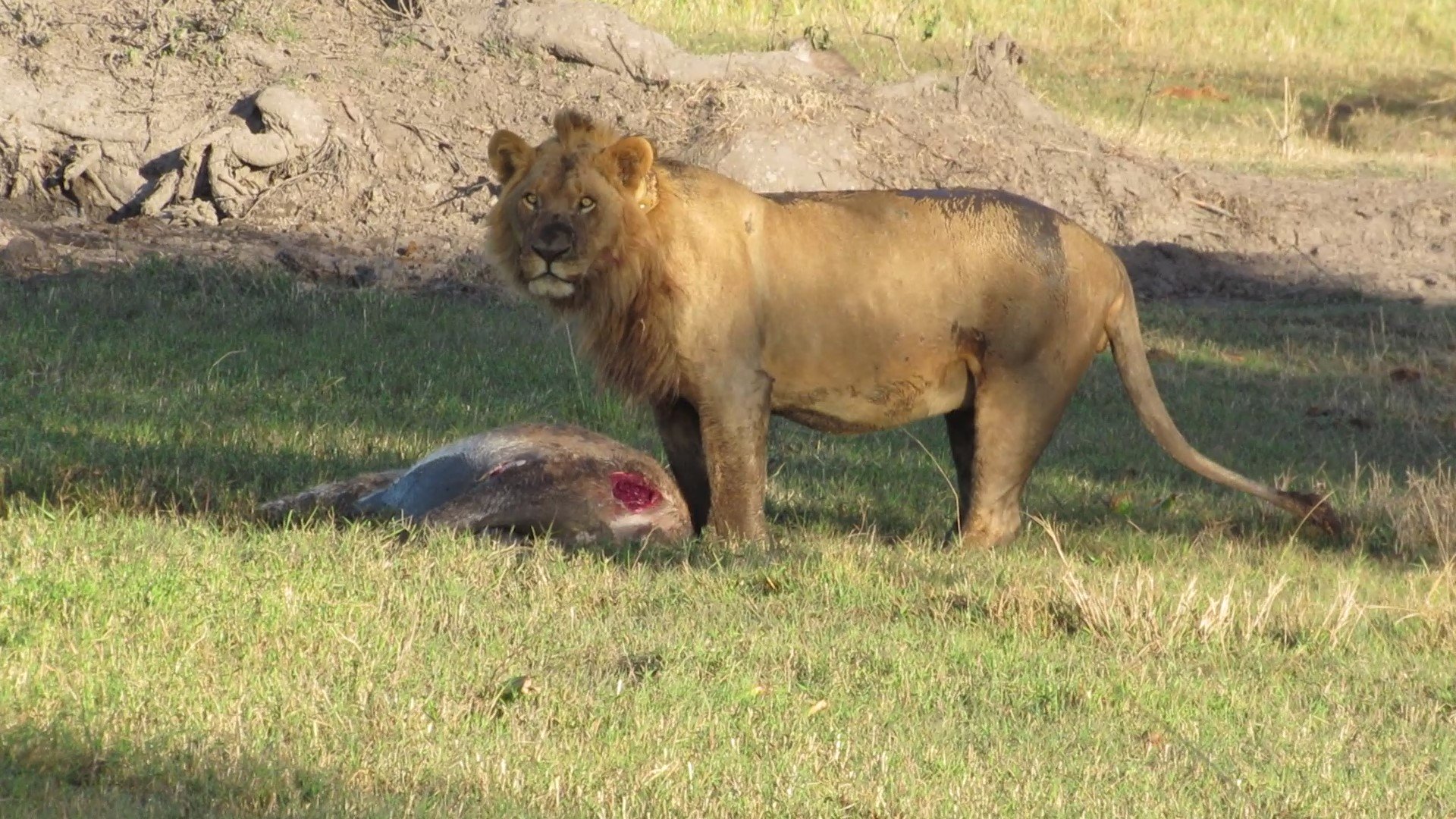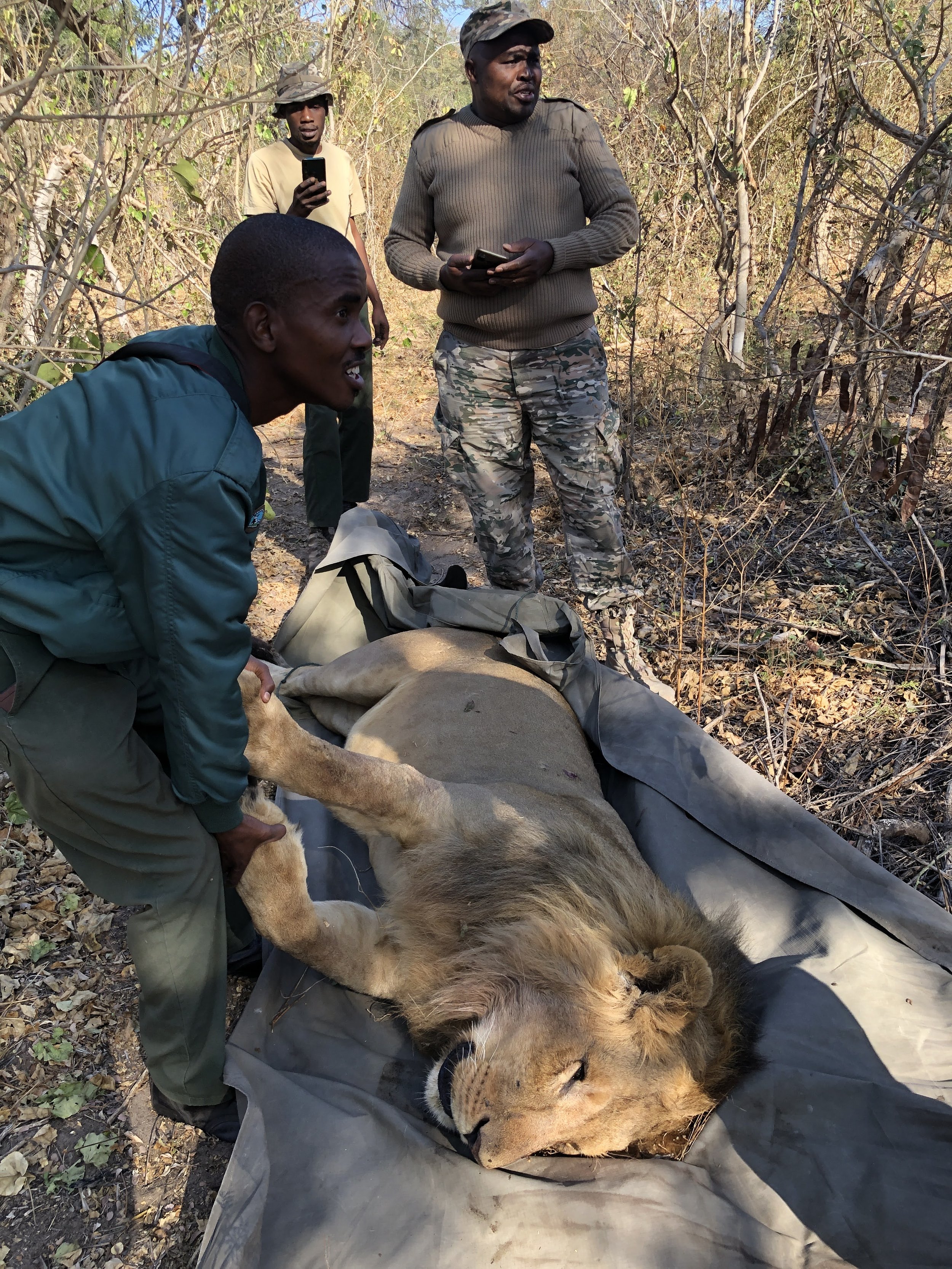A Second Chance for Young Lions
/The sun was just reaching it’s peak when a young man walked down a dirt track to the flood plains to check on his cattle. As he walked between the fence and the thorny thicket, his attention was brought to clear focus as he locked eyes with a young male lion feeding on a donkey. As the young man backed away slowly, the lion returned to feeding. It was not normal to see lions this close to the village, especially one so bold as to be feeding in full view. The Department of Wildlife and National Parks (DWNP) and CLAWS were informed and we raced out to capture the details. This was an ideal situation because our vet, Dr. Erik Verreynne, was with us for the week and we had tracking collars to deploy on conflict lions. This young male was a prime target!
Young male lion on one of the many donkeys he killed
As we came together, the young man shared his story. We discovered that there were three dead donkeys and Chris Dimbindo, our tracker, confirmed that there were in fact two young male lions about. The tracks led into the thicket and did not come out. After a few attempts, we had no way of getting close enough to dart. We would have to try the following day.
Upon our return, we discovered that the males had killed another donkey and fed on the meaty hind quarters. Considering their behavior and proximity to the village, these males were not long for this world. We could hear children, families, music and conversation where we were sitting. For their part DWNP released a warning to all in the vicinity to stay away from the flood plains.
After some time, the lions let Erik approach close enough to dart one to deploy a collar. He was a young disperser- between 2.5 to 3 years old. His mane was still growing in. He and his coalition mate are too young to hold a territory and found this place with ample food and no lions to harass them. What they did not appreciate was that they were in a very dangerous predicament and if they stayed much longer, they would not survive. DWNP, considering all of the challenges, decided that they wanted to translocate these troublemakers, but only had one cage. We let the collared male wake up. We knew we could find him for translocation when necessary using the collar.
Dr. Erik Verreynne lining up his dart with one of the young males
The following morning DWNP had collected a second transport cage, so we returned to dart both lions. As Erik and Andrew Stein, our director, approached, we saw the collared lion feeding on another donkey. That made 6 in 3 days! As he fed in the open we saw him begin his stalk towards an unassuming cow. We needed to get this boy out of here! Erik pulled the vehicle in between the lion and the cow to prevent the attack. As the male returned to the thicket to stalk more cattle, we still had not seen the second male. Was he still around? We loaded a dart to translocate this collared male just as the shy male appeared. Erik lined it up and darted the shy one. The two males ran into the thicket together. Not ideal, but at least we could follow the signal from the collar. We ventured in after them. Thorns scratching the vehicle sides, logs and stumps obstructing our path. We finally got a visual of the sleeping lion in the shade of a small bush. The collared male was nearby. Erik climbed onto the roof of his vehicle and sent a dart through several branches to hit the collared male. In a matter of minutes, they were both sleeping well and the support team of Botilo Tshimologo and the DWNP were with us. They offloaded tarps and six of us carried each lion to a cage and draped the tarp over. The lions were given a reversal drug so that they would wake quickly and not twist and flop while being transported.
Department of Wildlife and National Parks with one of the anesthetized young lions
We drove for 4.5 hours from Seronga to Selinda. As we passed each village heads were turning and people began to point and ask what was happening. It was quite a spectacle.
Eventually we found a suitable release point at small pan with water. We tied a rope to the cage door and fed it through a pulley and then through the back window of the pick-up. With a strong pull, the cage doors opened and the lions leapt to their freedom and ran for cover. As we looked in the cage we discovered that the lion had slipped his collar and it was laying in the cage. Clever boy. Knowing that this male was young, we had fitted the collar very loosely. Although we were now unable to track him, we knew that it was better to put a loose-fitting collar on the young male than too tight. He was going to grow quickly and young males have the ability to disperse large distances- just like our friend Mandlevu who now resides in Namibia.
The dirt track to the release point with lion in the covered transport cage
Overall the operation was a success. We removed the threat from the village and gave the lions a second chance. Generally we don’t advocate lion translocation except in extreme circumstances. In this case we knew that these males would face certain death in the village and the relative high human population in the area meant that there was a good chance that a surprise encounter was imminent.
This story is a reminder that we can make a difference for communities and lions. It is our responsibility. It is our best chance. It is our only chance.
Happy World Lion Day from CLAWS!
Botilo Tshimologo (center) with colleagues from the Department of Wildlife and National Parks




















